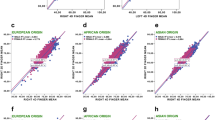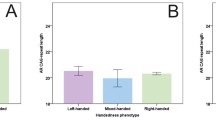The relative length of the second and fourth fingers (the 2D:4D ratio) has been taken to be an indicator of prenatal exposure to testosterone, and hence possibly relevant to sexual orientation and other sex-differentiated behaviors. Studies have reported a difference in this ratio between Caucasian males in Britain and in the U.S.: higher average 2D:4D ratios were obtained in Britain. This raises the question of whether differences among different Caucasian gene pools were responsible or whether some environmental variable associated with latitude might be involved (e.g., exposure to sunlight or different day-length patterns). This question was explored by examining 2D:4D ratios for an Australian adolescent sample. The Australians were predominantly of British ancestry, but lived at distances from the equator more like those of the U.S. studies. The Australian 2D:4D ratios resembled those in Britain rather than those in the U.S., tending to exclude hypotheses related to latitude and making differences in gene pools a plausible explanation.
Similar content being viewed by others
REFERENCES
Brown, W. M., Hines, M., Fane, B. A., & Breedlove, S. M. (2002). Masculinized finger-length patterns in human males and females with congenital adrenal hyperplasia. Hormones and Behavior, 42, 380–386.
Buck, J. J., Williams, R. M., Hughes, I. A., & Acerini, C. L. (2003). In-utero androgen exposure and 2nd and 4th digit length ratio: Comparisons between healthy controls and females with classical congenital adrenal hyperplasia. Human Reproduction, 18, 976–979.
Lutchmaya, S., Baron-Cohen, S., Raggatt, P., Knickmeyer, R., & Manning, J. T. (2004). 2nd to 4th digit ratio, fetal testosterone and estradiol. Early Human Development, 77, 23–28.
Manning, J. T. (2002). Digit ratio: A pointer to fertility, behavior, and health. New Brunswick, NJ: Rutgers University Press.
McFadden, D., Loehlin, J. C., Breedlove, M. C., Lippa, R. A., Manning, J. T., & Rahman, Q. (2005). A reanalysis of five studies on sexual orientation and the relative length of the 2nd and 4th fingers (the 2D:4D ratio). Archives of Sexual Behavior, 34, 341–356.
Ökten, A., Kalyoncu, M., & Yaris, N. (2002). The ratio of second- and fourth-digit lengths and congenital adrenal hyperplasia due to 21-hydroxylase deficiency. Early Human Development, 70, 47–54.
Putz, D. A., Gaulin, S. J. C., Sporter, R. J., & McBurney, D. H. (2004). Sex hormones and finger length: What does 2D:4D indicate? Evolution and Human Behavior, 25, 182–199.
Schultz, T. F., & Kay, S. A. (2003). Circadian clocks in daily and seasonal control of development. Science, 301, 326–328.
Wright, M. J., & Martin, N. G. (2004). The Brisbane Adolescent Twin Study: Outline of study methods and research projects. Australian Journal of Psychology, 56, 65–88.
ACKNOWLEDGMENTS
We are grateful to Ann Eldridge, Marlene Grace, Narelle Hansell, and David Smyth for assistance with the Australian data.
Author information
Authors and Affiliations
Corresponding author
Rights and permissions
About this article
Cite this article
Loehlin, J.C., McFadden, D., Medland, S.E. et al. Population Differences in Finger-Length Ratios: Ethnicity or Latitude?. Arch Sex Behav 35, 739–742 (2006). https://doi.org/10.1007/s10508-006-9039-1
Received:
Revised:
Accepted:
Published:
Issue Date:
DOI: https://doi.org/10.1007/s10508-006-9039-1




